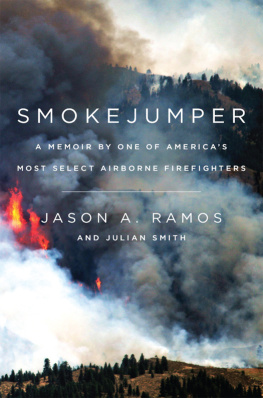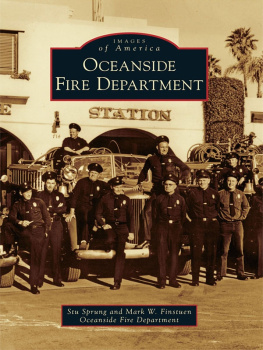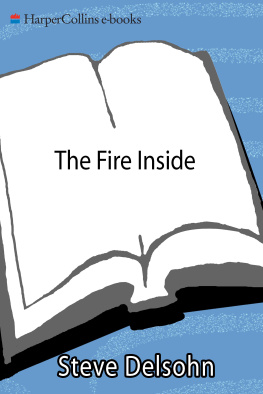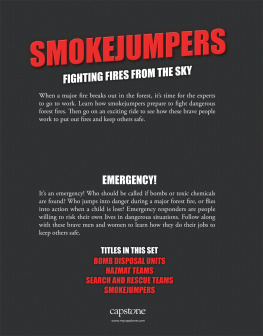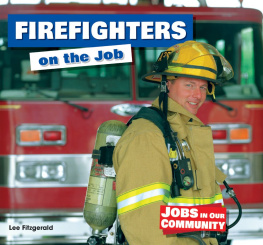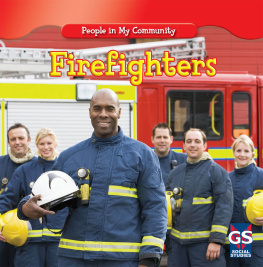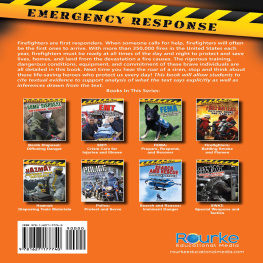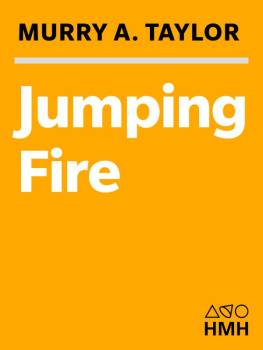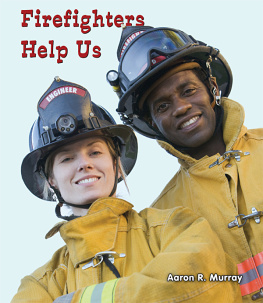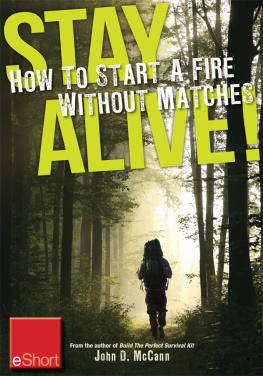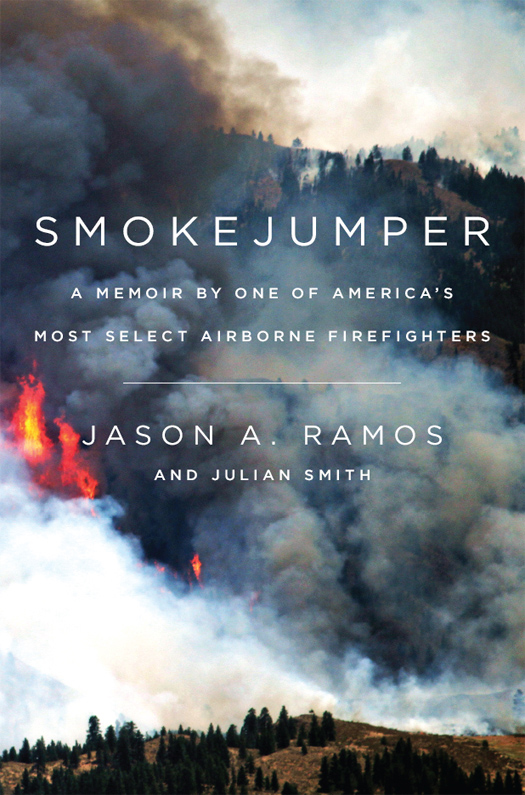I dedicate this book to my dad, for teaching me that a handshake
and the word of a man is all he has, and without that, youre nothing
Fire has always been and, seemingly, will always remain, the most terrible of the elements.
HARRY HOUDINI
Ive always followed my fathers advice: he told me, first to always keep my word and, second, to never insult anybody unintentionally. If I insult you, you can be goddamn sure I intend to. And, third, he told me not to go around looking for trouble.
THEODORE ROOSEVELT
CONTENTS
Guide
Map of smokejumper bases by Jenn Tate
Over the past three-quarters of a century nearly six thousand men and women have served as smokejumpers, leaping from airplanes to fight fire in backcountry. It all started when fifteen firefighters died on the Blackwater Fire in 1937 in Wyoming backcountry. David Godwin, an assistant chief of the Forest Service and one of the fire investigators, concluded that the management of the fire was intelligent and protective of the men. But it took so long to get to the fire that flames were far beyond control by the time firefighters arrived: a faster response by only a couple of hours, he concluded, might have saved fifteen lives.
Within two years, the smokejumper program was under development at Winthrop, Washington, and in Montana at Moose Creek and Seeley Lake. My family built a cabin on Seeley Lake in the early 1920s that we own and enjoy to this day; my father Norman Maclean, who was there when the early jumps were being made, later wrote about the smokejumpers first great tragedy, the Mann Gulch Fire of 1949, in his book, Young Men and Fire: he went from the cabin to see the fire while it was still smoldering. I wrote about the next one in my book Fire on the Mountain (William Morrow, 1999), an account of the South Canyon Fire of 1994 in which three smokejumpers and eleven other firefighters died in the flames; I did a lot of the work at Seeley Lake.
Today, the smokejumper program is in trouble. Partly to blame is the loss of backcountry: development has encroached into previously wild country, a lot of roads have been built, and helicopters can land where there are no roads. Modern regulatory life being what it is, however, many fire supervisors are suspicious of the smokejumpers, always individualistic, sometimes arrogant, prone to jump injuries. Smokejumpers dont fit in well with the bureaucratic slowness that too often marks getting started on a fire. Supervisors often decline to call for smokejumpers as a first resort instead of taking advantage of their finer qualities: quick to a fire, capable of independent action, tireless, and an inspiration to others to perform at peak level.
The good news is that smokejumpings storied past may help maintain its future. Jason Ramoss Smokejumper is a rousing personal adventure story, a nutshell history of the great wildland fires, and an insiders brief for making smokejumpers more relevant on todays fire line. Jumpers are the Swiss Army knives of wildland firefighting, Ramos writes. We dont just parachute into remote fires. We can also make it to close-in fires by helo or vehicle, often faster than anyone else.
Ramos is a Puerto Rican kid from suburban Los Angeles, small as smokejumpers run, who put in years as a municipal firefighter and helitack, shunned minority preferences, hid a serious injury, and eventually achieved his ambition to become a smokejumper. Thats enough material for a book, but there are other smokejumper books aroundand probably more to come as more jumpers step out of parachute harness and take up the pen.
What distinguishes Smokejumper is Ramoss mixing of fire history and personal anecdote. He interspersed his own story with brief accounts of the great wildland fires of the past, from the catastrophic Upper Middle West fires of the nineteenth century to the Yarnell Hill Fire of 2013. Ramos has personal ties to several of these fires: he lost a friend and mentor on the 1994 South Canyon Fire and went to the Thirtymile Fire in 2001 while it still burned, after it took the lives of two teenage girls and two young men on a fire crew. History comes to life through Ramoss personal connections.
The sites where these fires happened are more than sacred ground, the stories of what happened there more than tales of misadventure, and the casualty lists more than footnotes to historythough they are all these things too. Old fires carry embers that can turn to flame and teach new lessons to later generations. Firefighters can walk where others like them walked, face the decisions they made, and try to imagine how they would have handled a life-threatening situation. Civilian visitors get a strong dose of the price mostly young people pay to defend forests and homes, and may come away determined to do their part to make their homes defensible. These days, as fire seasons start earlier and end later, as fires burn hotter and become less predictableand those who fight them do not doubt thats whats happeningeveryone needs a greater awareness of the stakes involved. The spirit of these sites is always there to be discovered, but you have to look for it. Smokejumper is an invitation to do just that.
I met Ramos while I was researching the Thirtymile Fire and he was the public information guy for the North Cascades Smokejumper base in Winthrop, a couple of dozen miles from the site of the fire. The base managers kindly extended barracks privileges to me on several occasions, and Ramos and I became friends. He was a bundle of energy then and is the same today, running his own gear company, writing a book, and still jumping fires. But he also has a conscience. Sadly, none of the lessons from the past have stopped wildland fire tragedies from happening again in the future. As Ramos notes, the Granite Mountain Hotshots took a detour from a fire assignment to visit Storm King Mountain, site of the South Canyon Fire, a few years before they met their own tragedy in 2013, and they vowed nothing like that would ever happen to them. You cannot change the basic nature of fire, which is fiercely unpredictable in the extreme. But you can try to keep alive the lessons of the past to give those of us who live with fire better odds, and this Ramos has helped to do.
T HIS BOOK IS A memoir based on my recollection of past experiences over the years. I have done my best to fact-check my memory against any and every factual record I could find, as well as the memory of those who were there with me. When records were not available, I re-created events, interactions, and conversations, to the best of my ability. If I have misstated, misinterpreted, or misremembered anything, I apologize deeply and sincerely in advance. No current jumpers names are in this book, out of deference to their privacy.
As soon as I entered the fire service, back as a seventeen-year-old volunteer, I began to learn about the vast and mostly unknown legacy of the brave pioneers who served long ago. I hope this book is enjoyed by many and that it helps to inspire a new generation to carry on this proud traditionnot only for the smokejumper program, but for the entire fire service.
Sincerely,
Jason A. Ramos
ARE YOU READY?
The spotter was shouting into the side of my helmet. His voice rose above the roar of the planes engines and the wind howling through the open door.
My jump partner glanced out the door, then made way for me. I only had a moment to look out over the rippling green expanse of the Ochoco Mountains in central Oregon.

